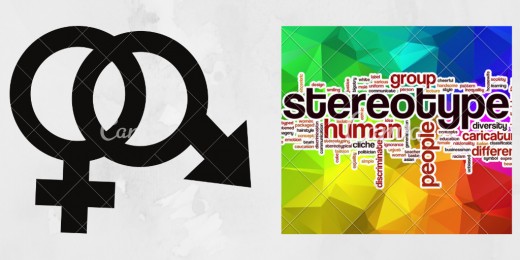Gender and Stereotypes
1.Introduction
The
study of stereotypes in relation to gender is important. This
importance lies in the fact that it can establish the sort of
relationship that survives between the component of gender. For
stereotypes in general may lead to loss or mis- communication.
2.Opinions about Gender and Stereotypes
Sherer
and Giles (1979 : 130) claim that the results of studies on the
perception and evaluation of speaker’s personality reveal that female
speakers are evaluated differently, and on the basis of different speech
clues.
For example, Kramer (cited in Thone and Hanley 1975 : 254) states that women speech is emotional, vague, euphemistic, sweetly proper, endless. In general, it is supposed to be weaker, less effective and more restricted. Kramer (cited in Smith 1985 : 151) adds that female speech can be summarized as friendly, gentle, enthusiastic, kind but unimportant and containing jibberish on trivial topics. While male speech, he says , is characterized as attention–seeking, dominating, authoritarian, aggressive and frank.
According to Zimmer and West (cited in Gumpers 1982 : 210) men make more direct declarations of factor opinion including suggestion and statement. But in contrast to this study, Jesperson (cited in Thorne and Henley –1975: 51) assures that women exercise a great and universal influence on linguistic development via their instinctive shrinking from course and gross expressions and their preference for refined, veiled and indirect expressions.
In addition to this, Zimmerman and West (cited in ward haugh 1986 : 317) notices that women in conversation ask more questions and use more instances of “you” and “we”, and do not protest as much as men when they are interrupted.
On another level, dealing with politeness, Lakiff (cited in Thorne and Henley 1975 : 17) describes women's language as more polite than males.
For example, Kramer (cited in Thone and Hanley 1975 : 254) states that women speech is emotional, vague, euphemistic, sweetly proper, endless. In general, it is supposed to be weaker, less effective and more restricted. Kramer (cited in Smith 1985 : 151) adds that female speech can be summarized as friendly, gentle, enthusiastic, kind but unimportant and containing jibberish on trivial topics. While male speech, he says , is characterized as attention–seeking, dominating, authoritarian, aggressive and frank.
According to Zimmer and West (cited in Gumpers 1982 : 210) men make more direct declarations of factor opinion including suggestion and statement. But in contrast to this study, Jesperson (cited in Thorne and Henley –1975: 51) assures that women exercise a great and universal influence on linguistic development via their instinctive shrinking from course and gross expressions and their preference for refined, veiled and indirect expressions.
In addition to this, Zimmerman and West (cited in ward haugh 1986 : 317) notices that women in conversation ask more questions and use more instances of “you” and “we”, and do not protest as much as men when they are interrupted.
On another level, dealing with politeness, Lakiff (cited in Thorne and Henley 1975 : 17) describes women's language as more polite than males.
By: MUSTAPHA KOURBANE








No comments:
Post a Comment